Articles
- Page Path
- HOME > Korean J Community Nutr > Volume 16(3); 2011 > Article
-
Original Article
- Analysis on Stress and Dietary Attitudes of Male Employees
- Mi-Ae Lee, Eun-Ju Lee, Hye-Kyung Soh, Bong-Soon Choi
-
Korean Journal of Community Nutrition 2011;16(3):337-352.
DOI: https://doi.org/10.5720/kjcn.2011.16.3.337
Published online: June 30, 2011
Department of Food Science and Nutrition, Catholic University of Daegu, Daegu, Korea.
- Corresponding author: Bong-Soon Choi, Department of Food Science and Nutrition, Catholic University of Daegu, 330 Geumnak 1-ri, hayang-eup, Gyeongsan-si 712-702, Gyeongbuk, Korea. Tel: (053) 850-3522, Fax: (053) 850-3516, bschoi@cu.ac.kr
Copyright © 2011 The Korean Society of Community Nutrition
- 1,114 Views
- 4 Download
- 5 Crossref
Figure & Data
REFERENCES
Citations

- Effectiveness of a mobile health intervention on weight loss and dietary behavior changes among employees with overweight and obesity: a 12-week intervention study investigating the role of engagement
Imhuei Son, Jiyoun Hong, Young-Hee Han, Bo Jeong Gong, Meng Yuan Zhang, Woori Na, Cheongmin Sohn, Taisun Hyun
Korean Journal of Community Nutrition.2023; 28(2): 141. CrossRef - Association between stress and dietary habits, emotional eating behavior and insomnia of middle-aged men and women in Seoul and Gyeonggi
Onjeong Choi, Jiwon Kim, Yujin Lee, Youngmi Lee, Kyunghee Song
Nutrition Research and Practice.2021; 15(2): 225. CrossRef - A study on Korean workers’ practice of brushing teeth after lunch
Jin-Sun Choi
Journal of Korean Academy of Oral Health.2020; 44(2): 97. CrossRef - Eating Habits of the University Students affected by Stress Levels in the Areas of Seoul and Gangwon Province
Jeongsill Lee
The Korean Journal of Food And Nutrition.2015; 28(5): 782. CrossRef - A Study on Dietary Behaviors, Health-Related Lifestyle of Adult Visitors at Public Health Centers in Gyeonggi Urban Area
Jong-Sook Kwon, Kyungmin Kim, Hyun-Chang Seo, Yoonna Lee, Seunggeon Lim, Young-Sug Choi
Korean Journal of Community Nutrition.2013; 18(6): 611. CrossRef
General characteristics of the subjects
Anthropometric data of the subjects
BMI : Body Mass Index = body weight (kg)/height (m)2
1) BMI < 18.5
2) 18.5 ≤ BMI < 23.0
3) 23.0 ≤ BMI < 25.0
4) BMI ≥ 25.0
Life habits of the subjects
Dietary habits of the subjects
The average score by job stress category
The higher the score, the higher the job stress (possible score 1 - 4)
The average score by daily life stress category
The higher the score, the higher the daily life stress (possible score 1 - 4)
Job stress levels according to general characteristics of the subjects
Values are N (%)
*: p < 0.05, **: p < 0.01
1) Below 42.4 according to job stress score
2) From 42.5 to 54.7 according to job stress score
3) Above 54.8 according to job stress score
4) Fisher's Exact test
Job stress levels according to life habits of the subjects
Values are N (%), ***: p < 0.001, †: Fisher's Exact test
1) Below 42.4 according to job stress score
2) From 42.5 to 54.7 according to job stress score
3) Above 54.8 according to job stress score
4) Fisher's Exact test
Job stress levels according to food habits of the subjects
Values are N (%)
**: p < 0.01
1) Below 42.4 according to job stress score
2) From 42.5 to 54.7 according to job stress score
3) Above 54.8 according to job stress score
4) Fisher's Exact test
Taste preference according to job stress levels
Values are Mean ± SD
The lower the score, the higher the preference (possible score 1 - 5)
1) Below 42.4 according to job stress score
2) From 42.5 to 54.7 according to job stress score
3) Above 54.8 according to job stress score
Food intake frequency score according to job stress levels
Values are Mean ± SD, *: p < 0.05
a, b: Means with different superscript letters are significantly different from each other at p < 0.05 by Duncan's multiple range test
1) Below 42.4 according to job stress score, 2) From 42.5 to 54.7 according to job stress score
3) Above 54.8 according to job stress score
Daily life stress score according to general characteristics of the subjects
Values are Mean ± SD: 4-point Likert scale (high score denote strong stress)
*: p < 0.05, **: p < 0.01
a, b: Means with different superscript letters are significantly different from each other at p < 0.05 by Duncan's multiple range test
Daily life stress score according to life habits of the subjects
Values are Mean ± SD: 4-point Likert scale (high score denote strong stress)
*: p < 0.05, **: p < 0.01, ***: p < 0.001
Daily life stress score according to dietary habits of the subjects
Values are Mean ± SD: 4-point Likert scale (high score denote strong stress)
*: p < 0.05, **: p < 0.01
a, b: Means with different superscript letters are significantly different from each other at p < 0.05 by Duncan's multiple range test
Correlation coefficient between food intake frequency and daily life stress
*: p < 0.05
BMI : Body Mass Index = body weight (kg)/height (m)2 1) BMI < 18.5 2) 18.5 ≤ BMI < 23.0 3) 23.0 ≤ BMI < 25.0 4) BMI ≥ 25.0
The higher the score, the higher the job stress (possible score 1 - 4)
The higher the score, the higher the daily life stress (possible score 1 - 4)
Values are N (%) *: p < 0.05, **: p < 0.01 1) Below 42.4 according to job stress score 2) From 42.5 to 54.7 according to job stress score 3) Above 54.8 according to job stress score 4) Fisher's Exact test
Values are N (%), ***: p < 0.001, †: Fisher's Exact test 1) Below 42.4 according to job stress score 2) From 42.5 to 54.7 according to job stress score 3) Above 54.8 according to job stress score 4) Fisher's Exact test
Values are N (%) **: p < 0.01 1) Below 42.4 according to job stress score 2) From 42.5 to 54.7 according to job stress score 3) Above 54.8 according to job stress score 4) Fisher's Exact test
Values are Mean ± SD The lower the score, the higher the preference (possible score 1 - 5) 1) Below 42.4 according to job stress score 2) From 42.5 to 54.7 according to job stress score 3) Above 54.8 according to job stress score
Values are Mean ± SD, *: p < 0.05 a, b: Means with different superscript letters are significantly different from each other at p < 0.05 by Duncan's multiple range test 1) Below 42.4 according to job stress score, 2) From 42.5 to 54.7 according to job stress score 3) Above 54.8 according to job stress score
Values are Mean ± SD: 4-point Likert scale (high score denote strong stress) *: p < 0.05, **: p < 0.01 a, b: Means with different superscript letters are significantly different from each other at p < 0.05 by Duncan's multiple range test
Values are Mean ± SD: 4-point Likert scale (high score denote strong stress) *: p < 0.05, **: p < 0.01, ***: p < 0.001
Values are Mean ± SD: 4-point Likert scale (high score denote strong stress) *: p < 0.05, **: p < 0.01 a, b: Means with different superscript letters are significantly different from each other at p < 0.05 by Duncan's multiple range test
*: p < 0.05

 KSCN
KSCN

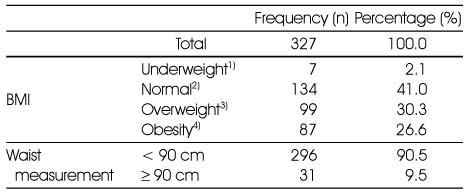

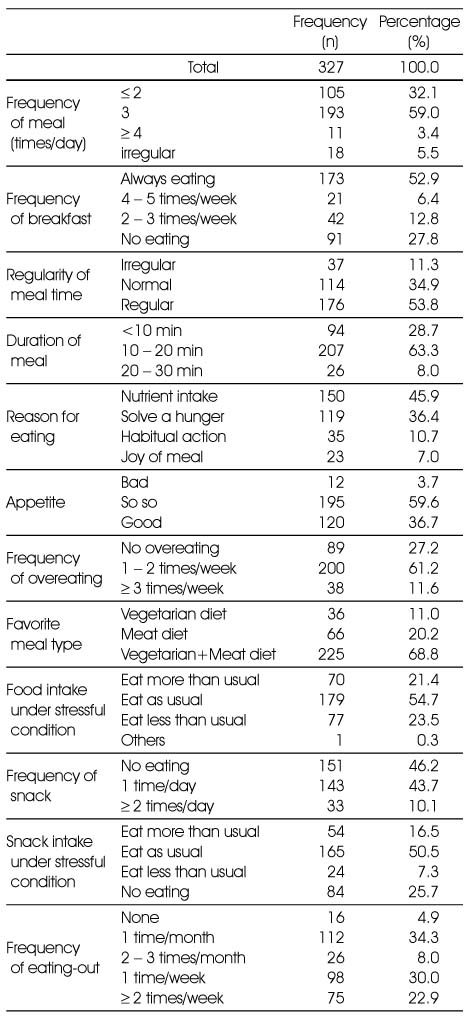
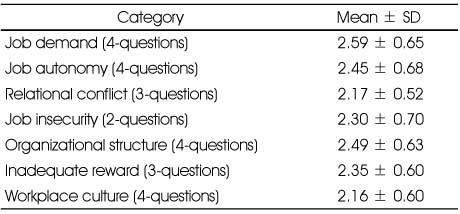

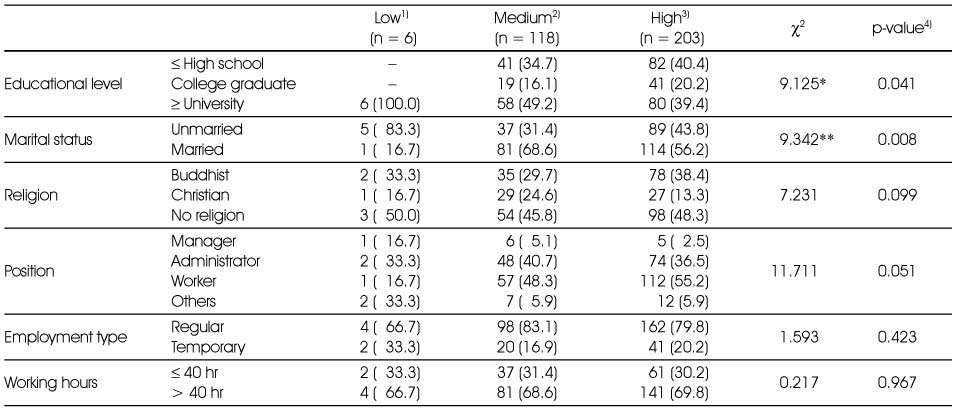
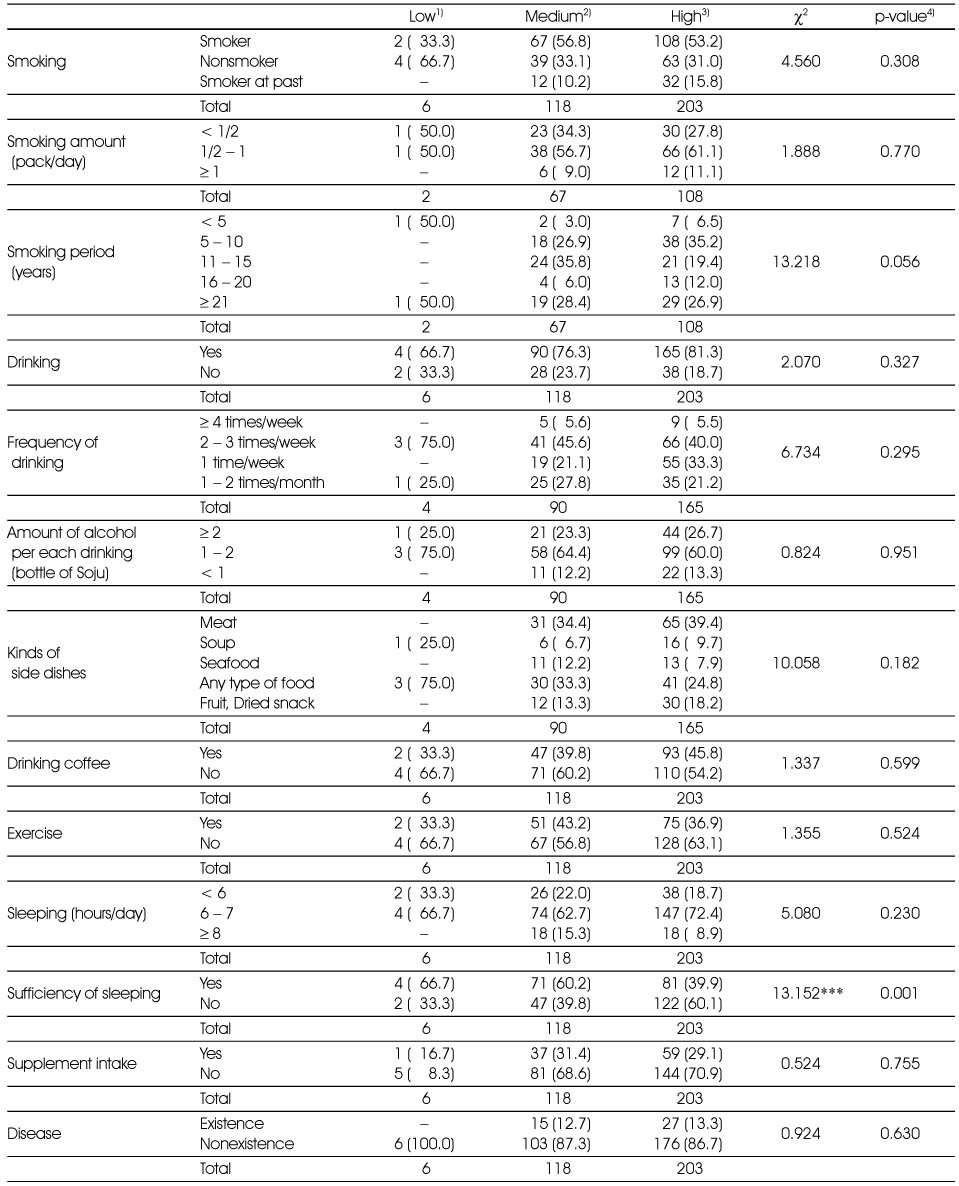



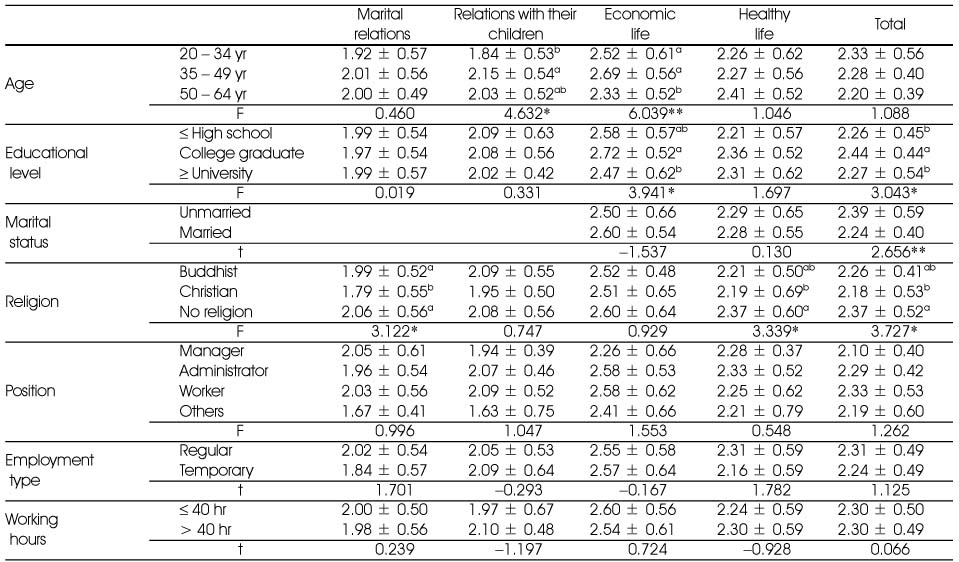
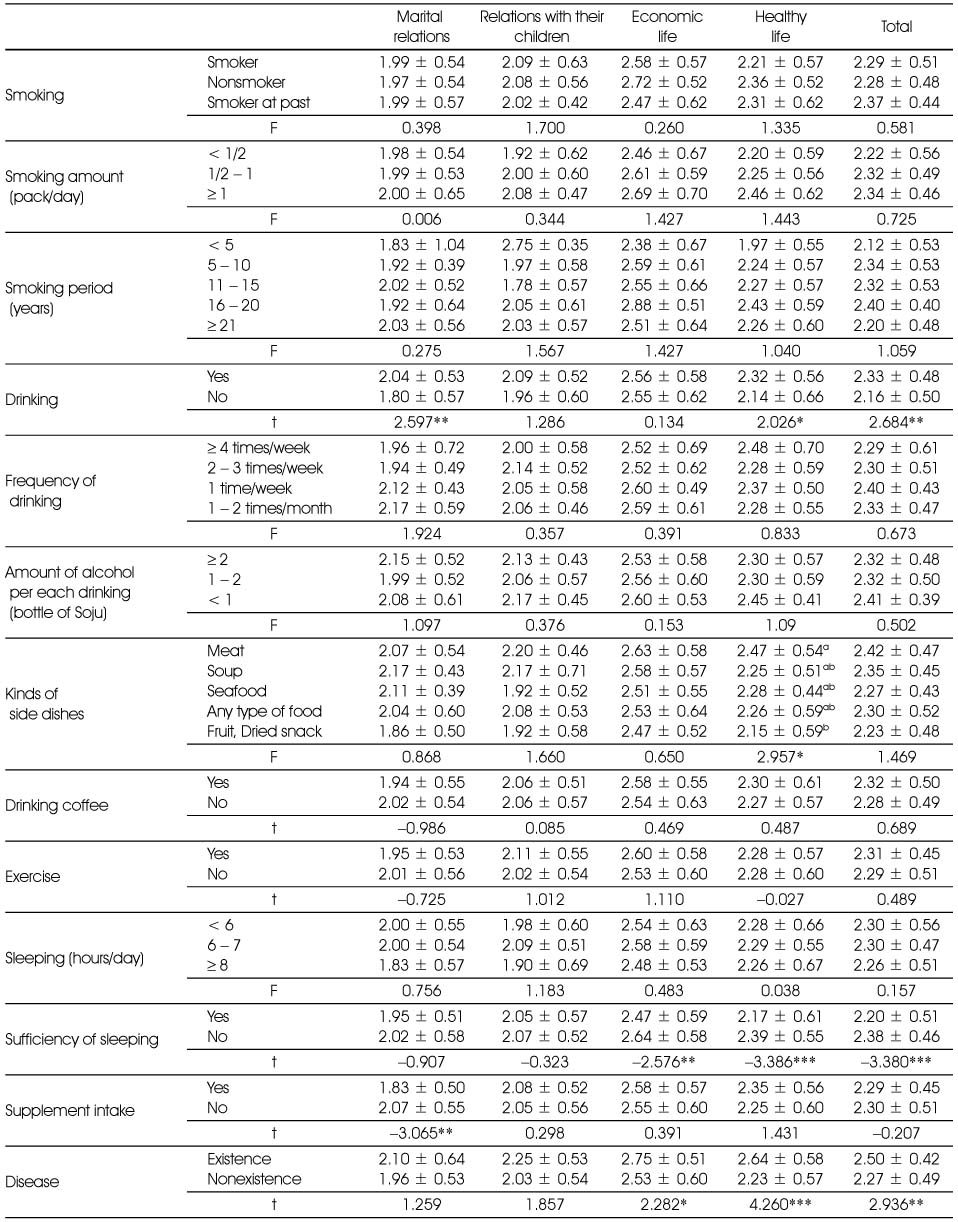


 Cite
Cite


